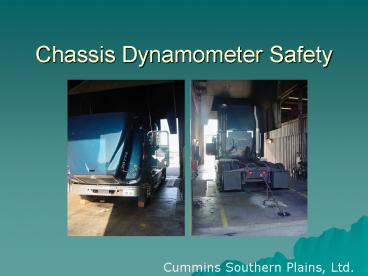Chassis Dynamometer Safety - PowerPoint PPT Presentation
1 / 17
Title:
Chassis Dynamometer Safety
Description:
Chassis Dynamometer Safety Cummins Southern Plains, Ltd. Chassis Dynamometer Safety Setting Up the Truck Inspection Running the Truck Ventilation System Additional ... – PowerPoint PPT presentation
Number of Views:1140
Avg rating:3.0/5.0
Title: Chassis Dynamometer Safety
1
Chassis Dynamometer Safety
Cummins Southern Plains, Ltd.
2
Chassis Dynamometer Safety
- Setting Up the Truck
- Inspection
- Running the Truck
- Ventilation System
- Additional Considerations
3
Setting up the Truck
- Attach the rear safety chain.
- The rear tie-down chain is the first restraint to
be installed, and the last to be removed. - Do not wrap the rear tie-down chain around brake
lines or other items that may be easily damaged.
4
Setting up the Truck
- Rear Safety Chain
Orange hook is a safety back up in case tensioner
fails.
A keeper to the boomer or load tensioner to
keep handle from popping off.
5
Setting up the truck (cont.)
- The front tie-down straps are the primary
restraints that provide safety in the event of a
problem. - The rear chain prevents forward movements, but
side-to-side movements may occur at the rear of
the vehicle. - Before beginning, know your dyno hood clearance
distance and that a FE is in the area.
6
Setting up the Truck
- Before placing vehicle on roller, make sure air
to the facility is turned on. If no air, truck
will roll off roller and may hit wall. Rollers
have air applied brakes/spring released. - Picture shows a dent in the back wall from a unit
that rolled off.
7
Inspection
- Always inspect the tie-down straps and ratchet
mechanisms for wear. Do not use excessively worn
or damaged parts.
On tie down straps inspect all strap material
and bolts.
Tie down chains inspect all bolts and keys.
8
Running the Truck
- Always remain in the drivers seat when conducting
a test. - Never allow observers to be in the room when
conducting a test. - Sensors may be connected to fluids under
pressure, or may still be hot after a cool-down
period. Use extreme caution when disconnecting
sensors. - Safety glasses and hearing protection must be
worn during a test.
9
Running the Truck
- Never apply the brakes or turn the steering wheel
while a test is in progress. - Always set the vehicle parking brakes and the
dynamometer roll lock when not executing a test. - Emergency stop button is located on the
wall-mounted interconnect box. In the event of an
emergency, press the button. - Nobody else should be in area when in operation.
Hole in the rear wall from a rock dislodge from a
tire during a test run.
10
Ventilation System
- Engine exhaust fumes contain particulate matter,
Carbon Dioxide, and Carbon Monoxide.. - Never run the engine or conduct a test without
the proper room ventilation and evacuation for
exhaust fumes. - At least one door of the chassis dyno must be
open during operation of the ventilation system.
11
Ventilation System
- These are different exhaust tubes designed for
different exhaust systems. The curved one in the
right picture is for busses with exhaust out the
top. Larger one in front for RVs. Be careful not
to place the tubes close to housing as it may
bubble the paint on an RV.
A variety of hose extensions should be available
12
Additional Considerations
Minimum ladder needed to take opacity
measurements on stacks is 8 ft.
Housekeeping with the hoses on the swing out rack
should be maintained at all times.
13
Static Electricity
- The rotation of rubber tires on steel rolls
causes static electricity build-up. - If the rear tie-down chain is wrapped directly
around the rear axle or frame cross member, no
further grounding should be necessary. - In all other cases it will be necessary to use a
grounding clamp attached to the dyno frame or
other suitable connection point to earth ground.
14
Fuel Safety
- Keep sparks and open flames away from fuel
measurement system and the output of the vent
connection. - Personal protective clothing should be worn to
prevent diesel fuel contact with the skin or
eyes. - Only diesel fuel can be used with the SF-602 fuel
measurement system. Other fuels may produce
dangerous vapors. The system is NOT explosion
proof. - The fuel can vent on the side of the cabinet must
be open to a safe place in the atmosphere. - A blocked vent could cause the can to burst or
leak.
15
Calibration
- Calibration arm and weight (500 lbs.) for
calibrating the sensor on the absorption unit.
Need two people for this lift and a cherry
picker. Calibration takes place once a year. - Need to open pit to access the mounting point for
the torque arm onto the absorption unit. Uses
cones and warning line around the pit to keep
people out.
16
Additional Safety Notes
- Always remove all test lead and exhaust
management devices before removing straps and
chains. This will save you from driving off with
expensive equipment. - Trip hazards from the test equipment and leads
can be a problem in the dyno room. Keep main
walkway clear as much as possible. - Oil and coolant spills are common. Housekeeping
is essential.
17
Questions?































